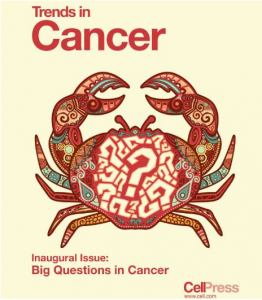Eight Big Questions in Cancer Research(Part One)
In October, the Cell Press launched its new sub publication Trends in Cancer. As part of the inaugural issue, the magazine invited the world leading cancer researchers to list the eight major problems currently facing the cancer research community.
[caption id="attachment_314" align="alignleft" width="262"] Trends in Cancer[/caption]
Trends in Cancer[/caption]
1.How can knowing the mutations that cause a patient's cancer shape treatment?
Scientists have spent decades to understand the precise genetic mutations that can lead to uncontrolled cell division. Now cancer patients can identify the genetic roots of their illness through their cancer gene sequencing, and we have targeted many of these genetic alterations, but we still have not obtained the majority of genomic data.
In 2015, President Barack Obama announced a national Precision Medicine Initiative (PMI) during his State of the Union Address. The plan includes a focus of cancer with an aim to identify new clinical situations in cancer where targeted treatment will be effective, to study potential resistances, and to develop databases that aggregate patients' health data to help doctors make better clinical decisions.
Douglas Lowy, Acting Director of the U.S. National Cancer Institute, said: "The precision medicine initiative in oncology is focused on treatment, however, we also need to recognize that prevention and screening are key areas that do not fall within the PMI per se but are areas where we look forward to making substantial progress."
Source: "Douglas Lowy: Precision Medicine gets Presidential Treatment"
http:// www.cell.com/trends/cancer/abstract/S2405-8033(15)00017-5
2. Can we reduce different cancers to a set of common traits?
Back to 2000, researchers Robert Weinberg and Douglas Hanahan proposed a "Hallmarks of Cancer" in a landmark Cell review(doi 10.1016/S0092-8674(00)81683-9). They defined a few basic principles of cancer including: evasion of apoptosis, self-sufficiency in growth signals, insensitivity to anti-growth signals, tissue invasion and metastasis, limitless replication potential, and sustained angiogenesis.
This review becomes the most-downloaded and most-cited paper in the Cell. After that, another new study adds two new flags: abnormal cell metabolism and evasion the immune system.
"The notion that cancer was a single disease (as might be concluded from the notion of a common set of hallmarks) was of course an illusion," says Weinberg, who studies the molecular mechanisms of cancer at the Whitehead Institute of Biomedical Research and MIT. "While the general principles of cancer formation may extend widely over many tumor types, the detailed behaviors of cancer cause each tumor to be a unique entity--a unique invention of nature."
Source: "Robert Weinberg: Beyond Hallmarks"
http:// www.cell.com/trends/cancer/abstract/S2405-8033(15)00013-8
3. Why should we care about the tumor microenvironment?
Cancer cells are not isolated. They work together and are common in the selection of blood vessels and extracellular tissues. A well-developed tumor is like an unpopular organ, stealing resources from the other parts of the body. The tumor microenvironment is an important part of the tumor growth and determines its existence, a idea which forces researchers to rethink the formation and development of cancer.
"In the past three decades, I have shown with David Dolberg that even potent oncogenes are not sufficient to form a tumor, only under certain circumstances," says Lawrence Berkeley National Laboratory's Mina Bissell, a pioneer in this area. "They need to collaborate with the immune system and require many other steps and events to make a cell truly malignant. The architecture of the tissues is the key to understanding why cancer is an organ-specific disease."
We also need to further study the different environments for breast cancer and liver cancer, and improve and maximize the three-dimensional model of cancers by using organoids surrounded by tumor related microenvironments, as such a study could help us to test therapies that keep tumors dormant or even prevent them from metastasizing, according to Bissell.
Source: "Mina J. Bissell: Context Matters"
http:// www.cell.com/trends/cancer/abstract/S2405-8033(15)00020-5
4.Does epigenetics play a role in cancer?
Cancers are often defined by the mutations that cause them, but mutations are not the only way to change the gene. We know that cancer is constantly changing due to the emerging field of epigenetic, which aims to understand the physical changes of DNA - not to change the genetic code but to change encoding's information (for example, to add a compound to the DNA sequence thus those genes are no longer expressed).
"Cancer epigenetics was transformed by the unexpected finding that many of the genes most commonly mutated in human cancers are epigenetic modifiers, thus clearly linking genetic and epigenetic processes in cancer," says Peter Jones, Research Director and Chief Scientific Officer of the Van Andel Research Institute.
"Indeed, some pediatric tumors seem to have DNA methylation alterations in the absence of detectable mutations," he says. "These findings strongly support the notion that epigenetic misregulation directly participates in carcinogenesis."
The future of cancer treatment may involve epigenetic therapies, which are currently being tested for particular lymphomas. Earlier success has been seen in blood cancers, rather than in solid tumors, but there is hope that they can be combined with immunotherapy to boost other patient responses.
The future of cancer therapy may be related to epigenetics, which is currently being tested for particular lymphomas. Earlier success has been seen in blood cancers(rather than solid tumors), but it is hoped that they can be combined with immunotherapy to improve the response of other patients.
Source: "Peter Jones: Leaving a Mark on the Cancer Genome"
http:// www.cell.com/trends/cancer/abstract/S2405-8033(15)00014-X

Your email address will not be published. Required fields are marked *